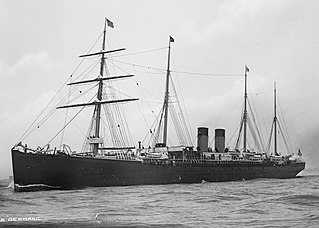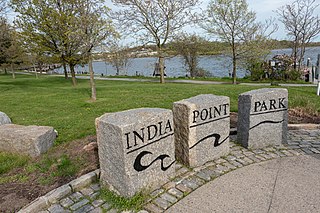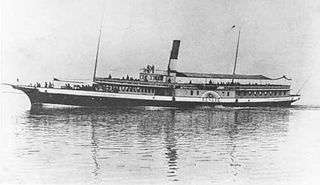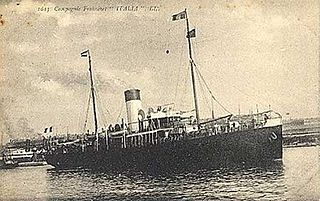
The New York, Providence and Boston Railroad, normally called the Stonington Line, was a major part of the New York, New Haven and Hartford Railroad between New London, Connecticut and Providence, Rhode Island. It is now part of Amtrak's high-speed Northeast Corridor.

SS Germanic was an ocean liner built by Harland and Wolff in 1874 and operated by the White Star Line. She was the sister ship of Britannic, serving with the White Star Line until 1904. She later operated under the name Ottawa until 1910. After passing into Turkish ownership she operated under the names Gul Djemal and Gülcemal, until broken up in 1950 after a total career of 75 years.

India Point Park is a park in the Fox Point neighborhood of Providence, Rhode Island at the confluence of the Seekonk River and Providence River. The park takes its name from the maritime activity connecting Providence with the East and West Indies. The East Bay Bike Path begins at the eastern end of the park, and crosses over the Washington Bridge before heading to Watchemoket Square in East Providence and continuing on to Bristol and the Mount Hope Bridge. The park is also a part of the Washington–Rochambeau Revolutionary Route.

The Fall River Line was a combination steamboat and railroad connection between New York City and Boston that operated between 1847 and 1937. It consisted of a railroad journey between Boston and Fall River, Massachusetts, where passengers would then board steamboats for the journey through Narragansett Bay and Long Island Sound to the line's own Hudson River dock in Manhattan. For many years, it was the preferred route to take for travel between the two major cities. The line was extremely popular, and its steamboats were some of the most advanced and luxurious of their day.

SSCzar was an ocean liner for the then Russian American Line before World War I. In 1920-1930, the ship was named Estonia for the Baltic American Line, then named Pułaski for the PTTO and as a UK Ministry of War Transport troopship, and as Empire Penryn after World War II. The liner was built in Glasgow for the Russian American Line in 1912 and sailed on North Atlantic routes from Liepāja (Libau) to New York. On one eastbound voyage in October 1913, Czar was one of ten ships that came to the aid of the burning Uranium Line steamer Volturno.

MS Genève is the oldest paddle ship of Lake Geneva. Originally a steamship, she became diesel powered in the 1930s.

Providence was a large sidewheel steamer launched in 1866 by William H. Webb of New York for the Merchants Steamship Company. The first of Narragansett Bay's so-called "floating palaces", the luxuriously outfitted Providence and her sister ship Bristol, each of which could carry up to 1,200 passengers, were installed with the largest engines then built in the United States, and were considered to be amongst the finest American-built vessels of their era.

The MVSerenade was a French ocean liner and later cruise ship, operating until 2008 when she was sold for scrap.
Heir to the Compagnie Fraissinet, Lieutenant Jean Alfred Fraissinet also served in the French Air Force during World War I, becoming a flying ace credited with eight aerial victories. Postwar, he took the helm of his family's shipping line in 1927. He founded two newspapers and bought another. He also bought the Château Saint-Maur and transformed it into a winery. The capstone of his career came in 1958, when he was elected to his nation's National Assembly as a member of the National Centre of Independents and Peasants.

SS Patria was an 11,885 GRT French ocean liner built in 1913 for Compagnie française de Navigation à vapeur Cyprien Fabre & Cie, for whom she was first a transatlantic liner and then an emigrant ship. From 1932 Fabre Line leased her to Services Contractuels des Messageries Maritimes, who ran her between the south of France and the Levant. After the fall of France in June 1940 the British authorities in Mandatory Palestine seized her in the Port of Haifa and placed her under the management of the British-India Steam Navigation Company. In November 1940, the Zionist movement Haganah planted a bomb aboard which sank her with the loss of between 260 and 300 lives. Patria remained a wreck in Haifa port until she was scrapped in 1952.

SS Italia was a French passenger steamship that was built as a civilian ship in 1904, requisitioned by the French Navy in the First World War as an armed boarding steamer, and sunk by an Austro-Hungarian Navy U-boat in 1917.

The Compagnie Fraissinet, a Marseilles-based shipping line, played an important role in trade and immigration flows in the Mediterranean, Black Sea, Western Africa and Latin America. The Compagnie Fraissinet added Northern America to its routes after a merger with the Compagnie Française de Navigation à Vapeur Cyprien Fabre & Cie. The Compagnie Fraissinet operated for close to 150 years through two World Wars, several revolutions, and the colonization and decolonization periods. The Fraissinet family started divesting from shipping activities in the 60s to concentrate on aviation and media. Fraissinet lowered its flag in 1968, the tanker Alfred-Fraissinet being the last ship of the company. Fabre kept on operating until 1979.
Général Bonaparte was a 2,796 GRT passenger ship that was built in 1922 by Chantiers & Ateliers de Provence for the Compagnie Marseillaise de Navires à Vapeur. She was torpedoed and sunk by HMS Sportsman on 19 May 1943 with the loss of 130 lives.
HMHS Chantilly was a passenger ship that was built in 1922 by Ateliers & Chantiers de la Loire for the Compagnie des Française de Navigation à Vapeur Chargeurs Réunis. She was sold before completion to the Compagnie des Messageries Maritimes. Captured by the British in 1941, she served as a hospital ship but was severely damaged by the explosion of Fort Stikine at Bombay, India on 14 April 1944. Chantilly was repaired and returned to her owners post-war. She was scrapped in 1952.
François Morelli was a French shipowner and politician. For a while he ran a shipping service in the western Mediterranean based in Marseille, but it suffered from severe competition and several business mishaps. After he was elected senator his business declined further, and then was declared bankrupt. He died in office shortly after its assets were sold at auction.

Count Jean Joseph Valéry was a French shipowner and politician who was Senator of Corsica in 1876–79. He inherited a line of steamships for passenger, cargo and mail services that he greatly expanded to operate between southern France, Corsica, Italy, Spain and Algeria. Later the company ran into difficulty with growing competition, and after his death the ships were sold off.

Missourian was an early American motor cargo ship which was built in 1921 in Chester, Pennsylvania, for the American-Hawaiian Steamship Company. She was sold to the British Ministry of War Transport in 1940 and renamed Empire Swan. Transferred to the Belgian government in 1942, she was renamed Belgian Freighter. She was sold to the Compagnie Maritime Belge in 1946 and renamed Capitaine Potié.
Kerr Steamship Company, Kerr Company, ran passenger and cargo ships from New York City the Dutch East Indies, Ceylon, Egypt and other ports. Kerr Company was founded in 1916, and was sold to Norton Lilly International in 1994 after a Kerr-Norton joint venture that started in 1981. In the 1920s Kerr Steamship Company was the largest steamship company in the United States. Kerr Steamship Company served during World War I taking supplies to the War. Kerr Steamship Company opened an office at 7 Rue Scribe, Paris and ran dock's at Bordeaux. Later, Kerr Steamship Company opened operations in Marseilles, Chicago, and New Orleans to support the war effort. In the “K” Line shipping system, the Kerr Steamship Company shipped most and sometimes all the cargo in Atlantic Ocean, "K" Line-Kerr Corporation. In 1994 Kerr Company was the sub-agent for United Arab Shipping Company, and is an agent for Torm West Africa Line, Alliance Navigation, Compagnie Generale Maritime, and Compania Chilena de Navegacion Interoceanica. Kerr was the sub-agent in the South Atlantic region for the "K" Line America.














